Betta fish are awesome, with their vivid colors and glorious fins they deserve a home that allows them to flourish and live a healthy life.
And what makes them great, is you really don’t need a high-tech set up. Making them great for beginners.
A simple 5 gallon planted tank, with some lighting and a sponge filter will provide a betta fish with a home it can thrive in.
Here’s how to choose equipment, set up the tank, and acclimate your betta.
Table of Contents
Step1: Picking Your Tank & Equipment
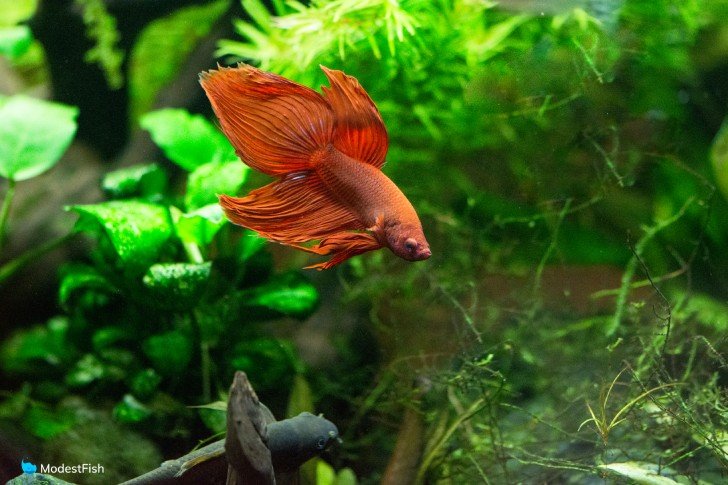
Here is a quick overview of what you’ll need
- Minimum 5 gallon tank but larger will be easier
- Heater
- Low flow filter
- LED lighting
- Thermometer
- Inert substrate
- Live plants
- Water conditioner
- Bucket for water changes
- Gravel vacuum for water changes
- Water testing kits
Picking Your Aquarium
Betta’s require at least a 5 gallon tank to be able to live in a healthy environment and flourish. I would recommend you check out your local fish stores as you can often find some great bargains on tanks. Just make sure it has a lid or you’re easily able to attach one. Bettas do jump.
If you want to order online, the Fluval spec aquarium kit is great for beginner betta fish owners and comes with almost everything you need to get started.
Picking your Heater
You need a reliable heater to keep the water consistent between 75°-81°F (23.8°-27.2°C). From testing different aquarium heaters, I would recommend you pick from the Fluval E series.
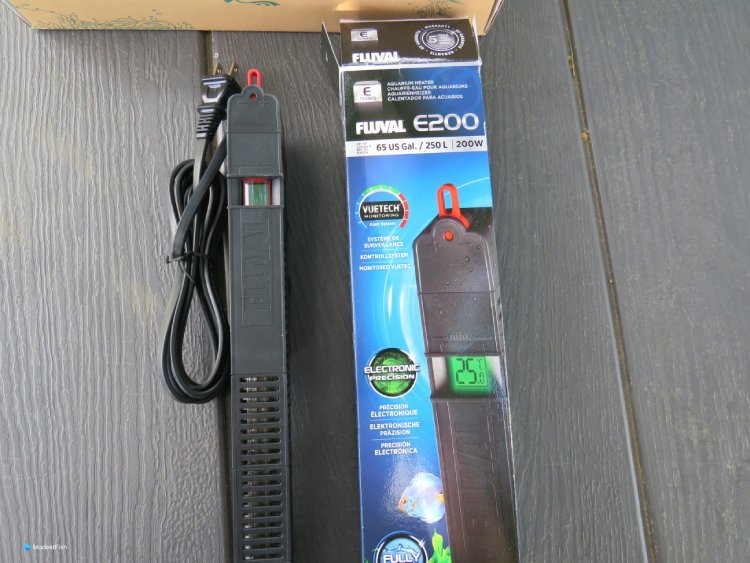
This heater is accurate, reliable, and comes with a heater guard so won’t damage your betta’s fins if it touches it.
Picking your Filter
A sponge filter will be most suitable for your betta fish. They’re not the strongest swimmers, so sponge filters will be enough for you to establish the nitrogen cycle, keep the water column healthy, but not blow your betta around the tank.
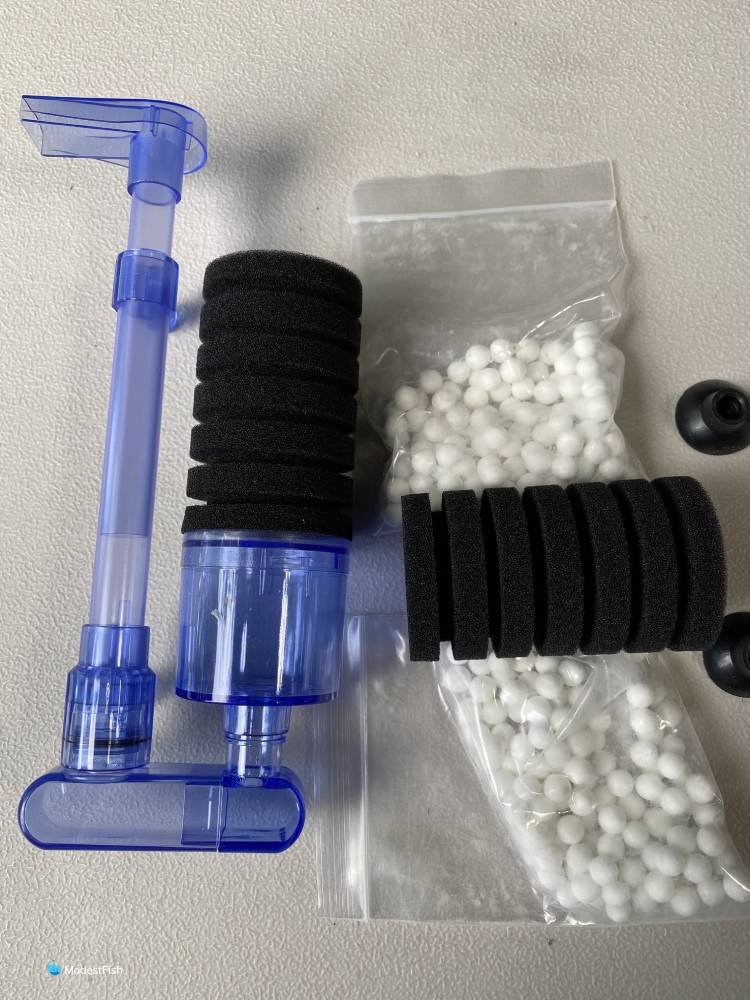
After testing different sponge filters, I found UPETTOOLS Biochemical sponge filter to be best for tanks in the 5-10 gallon range. If you’re going above 10 gallons, Hygger’s Double Sponge Filter will be your best choice.
To get the best filtration for your tank, use a filter with a GPH 4 x greater than the size of your tank. Example, a 5 gallon tank would be a filter with at least 20 GPH.
Picking LED Lighting
I’m going to recommend you keep live plants with your betta, as they absolutely love them. Which means a programmable LED light will make keeping the plants healthy and providing your betta with a consistent light/dark schedule easy.
I’ve tested a number of LED light fixtures and Hygger’s 24/7 LED kit offers outstanding value for money and would be what I recommend you check out.
Picking Substrate
Firstly, whatever substrate you use, make sure it’s inert. This means it won’t change and affect your water parameters. Smooth gravel, sand, or soft aqua soils will be your go-to here.
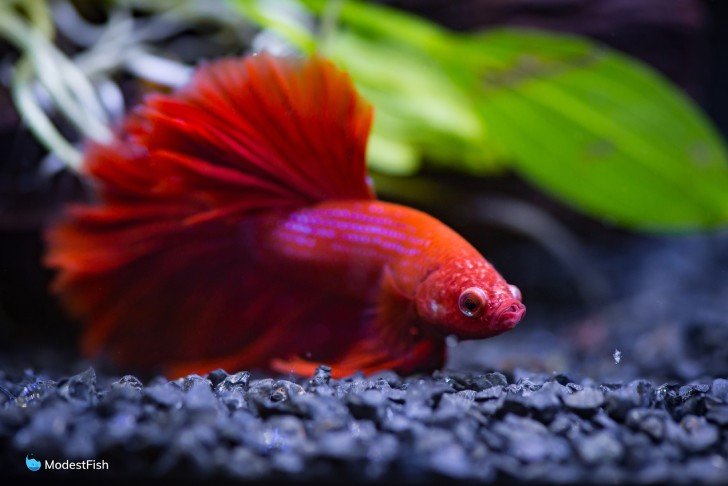
Ensure the substrate is smooth so your betta won’t damage its fins. For bright betta fish, a dark substrate from Seachem or Fluval would really make your fish stand out.
Picking Plants & Decorations
Any decorations will do. Bettas fish love a tank with toys and caves as they need some stimulation to stay happy. When choosing, just make sure there are no rough edges your betta could damage its fins on.
Live plants are an absolute must in my opinion.
You can try some beginner friendly plants like java fern, anubias, java moss, water wisteria, and marimo moss balls. As well as some floating plants like frogbit or dwarf water lettuce to discourage your betta from jumping.
You can learn more about picking plants for betta fish here.
Required Maintenance Equipment
You’ll be performing weekly water changes and monthly maintenance on your tank. So here are some other items you’ll want to pick up:
- Gravel vac for water changes
- 5 gallon bucket for water changes
- Water conditioner for water changes
- Thermometer to make it easy to check the water temperature
- Water testing kits (we compared some to lab results and found API Freshwater Master Kit most accurate)
- Aquascape tools for trimming plants
Step 2: Setting Up Your Betta Tank
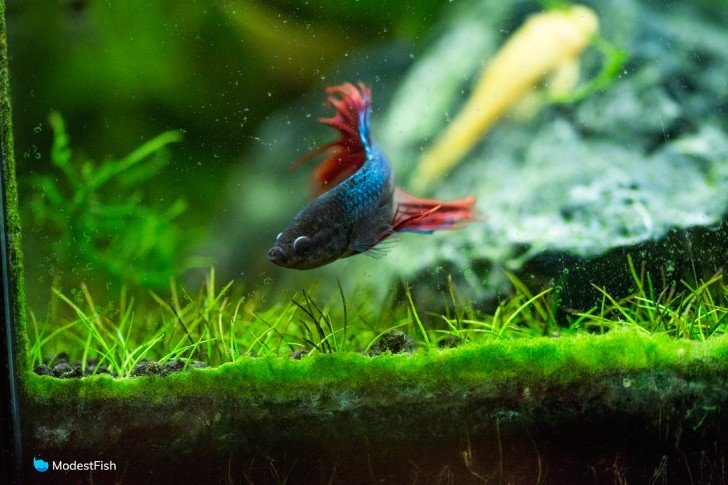
1. Preparing and Placing the Aquarium
Start by cleaning out your tank with just water, no soap! Then choose a sport that’s near a window, but not exposed to direct sunlight.
Make sure the surface is flat and sturdy – you may want to consider purchasing a stand designed to hole the weight of your tank. Leave five inches between the aquarium and the wall to allow for the filter.
If you have other pets, you may want to consider placing your Betta in a room they don’t have access to. Keep the tank out of direct sunlight.
2. Install Your Filter
Not all filters are the same, so different types will require different installation methods.
It’s very common that the instructions on filters are terrible. So I’d recommend you check out this guide we created on how to set up a sponge filter.
Make sure you don’t turn your filter on until your tank is filled with water.
3. Add Decorations & Hardscape
Adding this before substrate reduces the risk of your substrate shifting and destabilizing your hardscape and decorations.
If you’ve purchased decorations from a pet store, they just be safe without any major cleaning. Just rinse with tap water.If you’re concerned at all, you can use this guide we’ve created on making decorations safe.
4. Add Your Substrate
Give your substrate a thorough rinse with cool running water to remove dust which could clog your filter. Don’t use soap.
Then add the tank. If you’re using real plants, you’ll need at least two inches of gravel.
5. Partially Fill With Water
Fill your tank’s water up to several inches above the substrate and no further.
6. Add Plants
Adding in your plants with a partial water line will give you plenty of room to work with in the tank.
If you’re unsure how to add plants to an aquarium, we have a guide here on adding potted plants and here on how to anchor plants.
7. Finish Filling
Slowly fill your tank up with the rest of the water and leave about an inch gap between the water line and the top of your tank. Your Betta’s an anabantoid, meaning it’s able to breathe the same air as you and me by using a unique organ called a labyrinth. Cool, right?
Take this part very slow so you don’t kick up a bunch of debris from the substrate.
8. Turn on Your Filter and Install Your Heater
Now that you’ve filled your tank with water, it’s safe to turn on your filter. Make sure the water is circulating gently, soothly, and quietly.
It’s common your heater will come with suction cups to attach it inside your aquarium. Following the instructions, you’ll want to set the temperature so it’s between 75°-81°F (23.8°-27.2°C)..
Place your thermometer so you can easily monitor the temperature.
7. Perform The Nitrogen Cycle
The nitrogen cycle is the process we go through to ensure the water column is safe for fish to live in. During this process, beneficial bacteria will become established in your tank and filter media. Allowing ammonia (toxic) to convert to nitrite (toxic), then nitrite to nitrates (non-toxic).
That’s why you can’t skip this step. The beneficial bacteria will supplement your fish’s environment by neutralizing their waste.
The cycle is finished when Ammonia is at 0 ppm, Nitrites 0 ppm, and Nitrates are under 20 ppm.Read here for an easy-to-follow guide on how to cycle your tank.
Water Parameters for Betta fish:
- pH: 6.0-7.5
- Temperature: 75°-81°F (23.8°-27.2°C)
- Ammonia and Nitrite: 0 ppm
- Nitrate: <20 ppm
- GH: 3-4 dGH (50-66.7 ppm)
- KH: 3-5 dKH (53.6- 89.4 ppm)
Step 3: Picking Your Betta & How to Acclimate
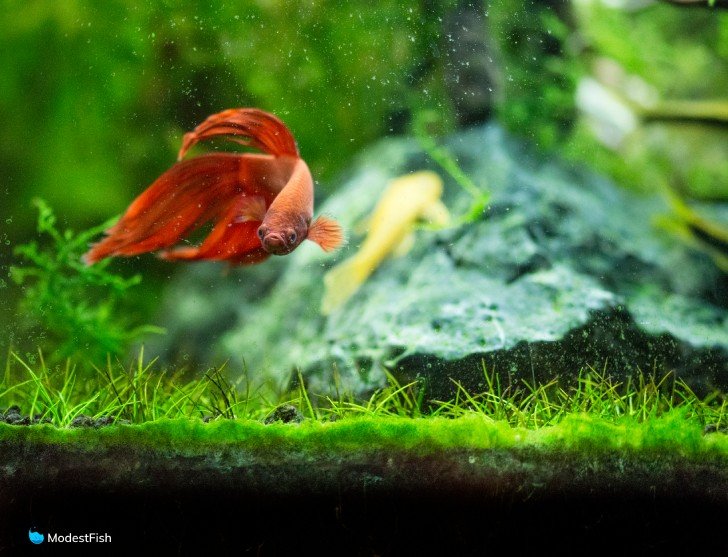
Don’t buy your Betta until your tank has finished cycling. It will just make the whole transition smoother. When your tank is ready, it’s time to go buy your Betta!
Here’s how to tell if a Betta is healthy:
- Bright body and undamaged fins
- The Betta is active and swimming well
- If it’s flaring at another Betta or you
- No deformities (missing eyes, fins, or scales etc.)
- No white dots or fuzzy substances (signs of disease)
How to Acclimate to New Tank
Acclimating your betta is easy. Just follow these steps:
Equipment:
- Small bucket or a specimen container (Dip & Pour)
- 8 oz cup
- Aquarium net
Steps:
- Start by floating the bag in the tank water for about 20 minutes so the temperature can slowly equalize.
- Next, put your betta into a small bucket, or better yet, a specimen container (what us old folks call a Dip & Pour).
- Slowly scoop 1-2 cups (200-500 milliliters) of tank water into the container. Continue to do this until you’ve doubled the volume of water the fish is in.
- Remove half of the water and discard it.
- Keep scooping in water until the volume has doubled again.
- Remove half of the water and discard it.
- Double the volume of water again, then net the fish and add it to the tank.
The live fish store should be able to tell you what their water parameters are, which you can compare to the parameters of your home tanks. Take extra time and care if there is a significant difference in your water versus theirs, especially when it comes to pH, GH and KH.
Final Thoughts
Betta fish are fantastic pets and they deserve to be treated right. After going through the correct method of preparing its tank, make sure you care for it properly.
This means, feeding your betta with a high-quality diet and keeping up with regular maintenance.
Monitor your pH, ammonia, and nitrate levels. And perform 20% water changes once a week to maintain a healthy environment.

if i am moving my betta from 1 tank to his new one do ineed to bag him from his old one and introduce him like that
Thank you for your comment. Yes, my advice would be to bag him with his old water and introduce him gradually to the new environment. Happy fish keeping!
So, i rescued our betta, Frederick from a gas station. Was in a bowl that was the size of a half a quart. And water had dehydrated bad, so not much water. He looked terrible. Guy finally sold me him for a quarter but told me not to expect him to live. He was waiting for it to die to flush him.. His fins where ragged. He just layed there. I knew a good tank could help him out if he didnt die. I have a 10 gallon i keep for quarantine, fry and live plants. So tank was ready for him. He still looked awful a week later, but he perked up and was active.. 3 months later, now he is gorgeous! Beautiful fins. I do a 20% water change once a week. I have a soap dish catching filter water to slow current down. So, im no weird animal lover, i just think this fish has some royal Caribbean coming.. is he fine being alone or is there other fish he will get along with? I know he will fight another male betta, but what about other types of fish? I have had some say this fish or that fish is fine.. told females only will be fine in the tank with him, then no, they are not. Which is it? Can Frederick have some buddies, or is he simply happy being a loner?
Thank you for your comment, Leslie. That’s a really nice thing you’ve done for Frederick. But, you don’t have to worry, he’s perfectly happy living alone. In fact, they tend to prefer it. However, depending on the personality you might be able to house it with a friend. You can check out more information here: https://modestfish.com/best-betta-tank-mates/ But there are no guarantees. Often I would advise not to house anything with a Betta because I can’t be 100% confident in my answer. Sometimes it works, sometimes it doesn’t.
Wish you and Frederick all the best 😀
Thanks so much for the response. I’ll let him be a bachelor and live alone. Thanks for the information. So much mixed info out there for betas. Gets confusing.
Yeah, I’ve only been able to house my Female better with other fish, Neons and Glow Fish. They all got along just fine but she may have had a more calm tempment.
Thank you for your comment, Kaylee. That’s great to hear :D. Yes, female bettas tend to have better temperaments than males because it’s males who compete for the female (the females hold all the power). But as usual with Bettas, it’s always hard to know how they’ll take to others.
I’m saving a betta thats been in a tiny, filthy, plant vase at my office for a year! They don’t feed it everyday, and its left alone on weekends. I finally got the person to give me the fish and I want to get it into a 5 gallon tank ASAP. I’m worried it might die before I can cycle the tank. Do you have any tips on how to keep it comfortable in its vase while i wait for the cycle to be complete? i don’t want to shock it.
Hello Michale, thank you for your comment. Oh my, that’s a situation. I would say keep a very close eye on the Betta, keep doing water changes, give it some plants to rest on, and just try to keep the conditions as stable as possible. Try to avoid overfeeding because you’ll risk ammonia spikes. Is the Betta in bad condition? If so, a epsom salt bath will do it some good. If the Betta has survived for a year in worse conditions, it sounds like a champ, hopefully it will be able to make it through the last bit before you introduce it to paradise. You can check out our article on The Nitrogen Cycle if you’d like: https://modestfish.com/how-to-cycle-your-aquarium/ there are some great tips in there for speeding up the process–might be you best option.
I’ve never owned a beta before, so I’m trying to do as much research as I can before I actually get one. 2 questions: When it comes to heaters, which is better, one that fits on the tank or one that fits on the bottom? I found one heater that fits on the bottom of the tank that you can cover with gravel. That seemed like a good way to do it, but your recommendation is one closest to the filter. And my second question is tank size. I live in a one-room apartment. I honestly don’t really have a space for a 5 gallon aquarium. Would a 2. 5 or 3 gallon tank be sufficient?
Hey Kat, thank you for taking the time to comment. It’s always a great thing to do research before you buy. I hope my answers can help you 🙂
1. I would recommend having your heater installed by the filter because it will help distribute the heat evenly throughout your tank.
2. Look, Betta’s can survive in a 2.5/3gallon tank. However, I don’t recommend it because I’ve read the studies and it does have a negative impact on the fish’s health. You may also have issues other because when you own a smaller tank, any sudden changes (like your heater malfunctioning) will have a much greater and faster effect on your tank’s ecosystem. Have you had a look at the Fluval 5 gallons? They have a pretty small footprint, so you can fit them into tighter spaces. Here’s the Fluval Chi II and the Fluval Edge.
I wish you all the best. Happy fishkeeping.
Thanks so much for responding! I haven’t, but I will look into both aquariums. I definitely want happy fish!
I have a betta in a 10 gallon with a filter, heater and lighted cover. I put live plants, a castle, dragon and moss ball and he loves it all. At first he was upset and even puffed at me and would hide near the pump but now he swims through the castle and dragon’s mouth, looking at me like look mom! I’m having fun. Today I introduced 2 albino Cory fish and he seems happy with them! Thank you for the tip about the heater near the pump filter! I’m still learning and talking to knowledgeable people. Most people in the pet stores don’t have any idea!
Hey, tank you for taking the time to comment. Awesome, super happy to hear you’re enjoying the hobby and you found my site useful! I’m sure you’ll be 10 tanks deep soon. Unfortunately this most pet stores, this is the case. No point getting mad at the workers though, they’re likely just trying to make ends meat and probably don’t get the proper training needed. I always recommend taking anything they say with a pinch of salt, politely accept their advice. Then go home, ignore their advice and do your own research :D. If you have anymore questions or have any thoughts on information you’d like me to write about, feel free to let me know!! Happy fish keeping!
People at petstores usually don’t know what they are talking about. I watched an employee tell a mom that two male bettas can stay in a bowl together. The mom then bought one bowl and two bettas. I was going to say something but I decided not to because people get angry where I live and I didnt want to start anything. Ive seen the same with goldfish too that they can live in bowls which is a lie goldfish can get to the size of the bowl, ive even heard someone even say that a saltwater fish can be paired with freshwater fish.
Hi my sister is going to get a Betta fish soon and wants to know what supplies she needs in order to help it stay alive and live a happy life! She has a 10 gallon tank she will put him in and that’s about it. Do you have any recommendations on what filter, heater and light she should get?
Also this article was really helpful! Thanks so much!!
Hey Ken, thank you for your comment. Your sister is definitely on the right path with the 10 gallon!
For a light, go with LEDs. Cost more upfront, but you save a lot on you electric in the future.
You can check out our article here: https://modestfish.com/best-led-lighting-planted-aquarium/
For your filter, I think a HOB filter would be great for a Betta tank.
You can check out our article here: https://modestfish.com/best-hob-filters/
For your heater, you have plenty of great options. Check out this article: https://modestfish.com/best-aquarium-heaters/ They will all do a good job for you.
This information was really helpful and accurate! I have owned and attempted to breed Bettas for a few years, but I am still learning. I have a couple of questions to ask, though.
1. How often should I monitor the pH,Ammonia , and Nitrate after the cycle?
2. Where do you recommend that I buy my Betta?
Thank you!
Sorry, for the delayed response, I sometimes struggle to juggle the comments with my daily life and work.
1. Check everytime you do a water change. Easiest way to keep track.
2. Don’t fear too much about where you buy it (unless you want to breed, then try to get from a reputable breeder), more look for the qualities of a healthy Betta.
Best of luck
So I’ve had my male betta from about a month now in my 10 gallon tank. My friend had a sorority in her 10 gallon tank but two days ago it broke and only two of her girls survived. She wants me to keep them and breed them with my male but i only have an old 3 gallon (i think) and i find it a very bad idea to have the two girls in that small of a tank so should i take my male from his 10 gallon and put him in the smaller one? Or will it be too bad for his health? Or should i put him in my breeder tank and the females in the 10 gal and let himmfloat around like that until my friend gets a new tank?
By the way the two females are living in two big plastic cups so i want to get them in a tank as soon as possible
Hello, thank you for your comment. Things could potentially get messy if you put the females with the males. If you’re just waiting for your friend to get a new tank, I would say putting your male in the 3 gallon (use water from his normal tank for his new tank to help,) and the females in the 10 gallon would be your best option. It might cause your male a little stress, but if it’s just temporary, you should be fine.
Hello, I’m just starting out with the hobby, and I am about to get a new tank, fish, plants, etc.. With that in mind, would it be better to introduce the male betta first into the tank, or other tank mates such as neon tetras, ghost shrimp and snails? And is it possible to house both a male and female in the same tank if there is enough foliage, or tank space? Or is it purely based on luck if they fight or not? Cheers!
Thank you for your comment, Ryan. You should always be very careful when housing your betta with another fish. Males and females should really only be together during mating. Check out this article here for more information: https://modestfish.com/best-betta-tank-mates/
I just purchased two male bettas from Petsmart. I have them in 2 different 3 gallon tanks. Unfortunately I wasn’t told to slowly introduce them into their new tanks. They came in small bowls and I put them straight into their new tanks after allowing the filter to run for 24 hours and the water clarifier to run through. The fish have not moved or come out since moving them into their new tanks. One sits up by the filter and the other sits inside his plant. It has been 24 hours since I moved them. Is this a sure sign that I stressed them too much? Should I assume they may die?
Thank you for your comment, Heather. You’ve put them in a new environment, Bettas are sensitive fish, give them time and let them be for a bit.
Hello! I’m currently planning on getting a betta fish for the first time and I have some questions. I don’t really have the space for a 5 gal tank so I was wondering if either a 3.5 or a 4 gal tank would be okay for a betta fish. And I’ve been researching that if you have a tank that’s less than 5 gallons, you shouldn’t have a filter because the current can be too strong for the betta. I know it’s hard to keep an unfiltered tank clean most of the time, but I was wondering if there was any way I could effectively keep the tank clean. Thank you!!!
Hello, Ericka, thank you for your comment. When it comes to tank size, I tend to be a bit brutally honest with people. Let me put it this way, would you buy a dog and keep it in a small room, unable to provide the space needed for it to be happy and healthy, just so you can enjoy having a dog? I would guess and say no. It’s not your fault, so please don’t take it personally. People don’t value a fish’s life in the same way they value other animals lives because of how people are educated on pet fish. About the filter… wow, I’m shocked you’ve been advised this. You can easily get a sponge filter (low flow)or a HOB filter (again, low flow). Filter strength varies from filter to filter and there are tons of tricks you can do to lessen the water flow. If you don’t have a filter, how will you possibly keep a stable nitrogen cycle so you don’t risk poisoning for fish?
Thank you so much for replying! And I appreciate honesty. I really want to try to be a good betta fish owner, so I’m researching a lot. Would a taller 5 gal tank be sufficient? And as a beginner I’m not sure I know what a nitrogen cycle is. Not a lot of sites I visited mentioned it. What’s your estimate on how much a sponge filter is?
No problem! I always try to reply as much as I can! A taller 5 gallon would be fine 🙂 and you can get all the information about the nitrogen cycle here: https://modestfish.com/how-to-cycle-your-aquarium/ Feel free to ask any more questions you may have and I promise I will reply as soon as I can. Sponge filters can be bought on Amazon for as little as $10/15. Even if you can’t afford top of the range, having some filtration is always better than none.
Hi there,
Just wanted to say that I love your write up, it’s extremly helpful and informative. Thank you.
My question is, when I’m setting up my tank, would it be wise to add aquarium salt?
Right now I have an existing tank with a Betta that I’ve place an Indian almond leaf inside. I want to move him to another tank and I’m wondering whether it is okay to place both almond leaf and salt in his new tank? Thanks!
Thank you for your comment. There is no need to add aquarium salt to your Betta tank because they’re freshwater fish
I’ve had a betta since the end of July. First time I’ve ever owned a fish (my daughter wanted it). This fish always hides in the upper back corners of the tank. It rarely swims around when we’re in the room (although when we leave and then we come back, we’ll sometimes get a glimse of him swimming around, but when he sees us he goes back to the corner). He has a sponge bob house in his tank as well as some silk plants and one of those leafs he can lay on. But he never goes in or around those things (although one time we hid head first into one of his plants….weirdest thing I ever saw). Is all of this normal or is he just an odd fish?
Thank you for your comment, Julie. Sorry to hear your Betta is not particularly social, but it could be for a few reasons. One, it could still be adapting to its new home and may just be taking a while, and two, it might just be that your fish is a shy one. Bettas all have unique personalities so some will be more boisterous than others.
Hi! So I just got my 2 bettas the day before yesterday, and I kept them in separate tanks. I followed the steps for introducing my bettas to the tanks. The female was eating the food I gave her, but it looks kind of pale and keeps going to the four edges and I don’t know what is happening. WHAT IS HAPPENING?
Hello, Amy. Thank you for your comment. This could be a number of things, it’s hard for me to give you a concrete answer without knowing all of your water parameters, tank/equipment, and how you maintain your tank. Pale Bettas are usually a result of poor water quality, boredom, or being in small spaces. I recommend you test your water conditions and depending on the size and what’s in your tank, you may want to add more plants/decorations or upgrade the size.
I have a betta that seems to have internal parasites. He’s in a 10 gallon heated, filtered tank with 7 khulis, some of whom may also he infected, so I have treated the tank with API General Cure.
The treatment isn’t fully finished, yet the heater in the tank now seems completely non functional, and the water is cold! They’re already sick, so my heart is just breaking over this, but I don’t want to remove them mid-treatment and potentially hurt them, more. I have another heater I can use. Is there any way I can put the new heater in with them? It’s normal for me to run the heater 24 hours before adding fish!
Hello, Mindy, I’m sorry to hear what is happening. If your only option is to put the heater straight in, then I recommend doing it. Wish you all the best
Thanks for explaining how a betta fish tank should be setup. It’s good to know that it’s important to have a tank that had decorations, like plants that provide shady areas. It sounds like it could be good to maybe have a bigger tank as well so more decorations can be placed for the fish to hide in.
Appreciate it for helping out, fantastic info.
It’s really very helpful Adam sir
Thanks for giving me a needy suggestion
Today, I extracted the fluid from my betta’s drospy belly by sedating him with clove oil, and using a 31 gauge insulin syringe. I also treated the water with BettaFix for the past four days in case the dropsy is bacterial and not kidney based (I ruled out constipation). I’m changing a portion of the water every two days and added a heater to his tank. Wow! What a difference. This is the happiest he has ever been since I purchased him. Hopefully, he will recover, but I know there’s a chance he’ll go downhill again if this is kidney related. In the meantime, I’ll keep monitoring his condition and will switch to an antibiotic if necessary. I’ll also continue to make improvements to his care by mixing up his diet and adding appropriate plant life and accessories to nurture him in a healthy environment. I want to enjoy his company for as long as he’s here. Fingers crossed.
I was very pleased to uncover this website. I want to to thank you for ones time for this particularly fantastic read!! I definitely loved every bit of it and I have you bookmarked to check out new stuff in your web site.
This information is really helpful, I didn’t realize I had made a bunch of mistakes when taking care of my fish
A very good presentation of the essential facts. Thanks a lot!
That’s very nice